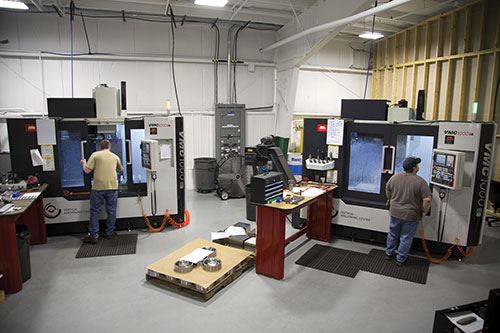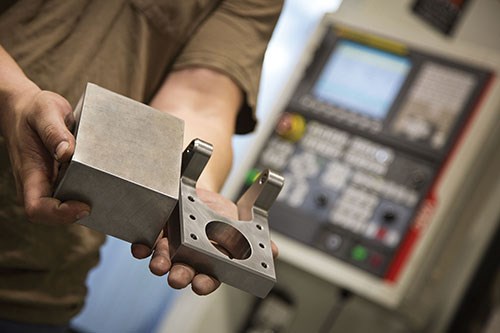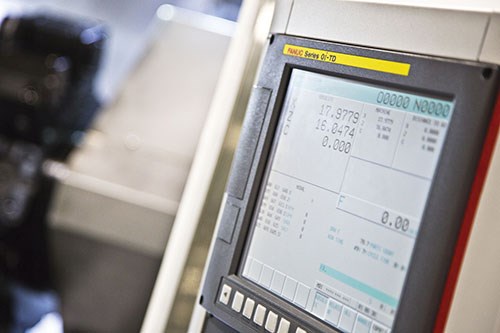VMC Improves Shop’s Flexibility, Efficiency
RDM Manufacturing Precision CNC needed to improve its equipment flexibility to keep up with its large variety of clients. Investing in a VMC from SMTCL enabled the shop to achieve higher metal removal rates and better surface finish to better deal with demand.
Share



Takumi USA
Featured Content
View More





Hwacheon Machinery America, Inc.
Featured Content
View More

ECi Software Solutions, Inc.
Featured Content
View MoreA highly diversified job shop has many merits. One advantage is that if a particular industry is in a slump, the shop can lean harder on the products it manufactures for other industries to carry it through. However, high diversification can also lead to struggles, as RDM Manufacturing Precision CNC of Fenton, Michigan, experienced. The shop needed to improve its equipment flexibility to keep up with its large variety of clients. By investing in a vertical machining center from SMTCL, it was able to make heavier cuts and efficiently run a variety of steel and aluminum parts.
Since its founding in 2013, RDM has grown to include customers in industries such as aerospace, automotive, medical, off-road and industrial machinery. Part runs range from a single piece to more than 100,000 in materials ranging from forgings to hardened die steels to aluminum. Keeping up with this array of clients, part runs and materials is a competitive advantage for RDM, but it places high demands on its staff and equipment to be both flexible and efficient.
RDM initially invested in a number of entry-level VMCs, which it relied on for the first 18 months of operation. However, as business continued to expand, co-founder Randy Birchmeier realized that these machines weren’t as productive as they needed to be to meet the shop’s increased needs.
He and his team visited the 2014 International Manufacturing Technology Show to evaluate several VMCs from Japanese, Taiwanese and European builders, ultimately deciding on the higher-performance VMC1000B machining center from SMTCL Americas (City of Industry, California) that had a similar price point to the shop’s current machines, even though he had budgeted for a more expensive one.
The new machine also is similar in size to RDM’s existing machining centers. Standard equipment includes a FANUC 0i-MD control; a 10,000-rpm, coolant-through CAT 40 spindle; and a conveyor-style chip remover. It also features a 47.2-by-19.6-inch table, which enables parts to be machined in one setup.
One of the main reasons RDM selected the SMTCL VMC was the larger casting and machine weight. With a gross weight of 15,400 pounds, the VMC1000B outweighed the shop’s existing machining centers by more than 3,000 pounds. In addition to providing additional stiffness and vibration damping, the larger casting also improves thermal stability by absorbing heat into its webbed design, which resists heat growth that can lead to repeatability problems.
The larger casting and increased weight also enable RDM to take more aggressive cuts. For example, on a 6160 aluminum part, RDM was able to take a 0.5-inch depth of cut with a 2.5-inch face mill, which would’ve stalled the previous VMC, the shop says. Also, on a series of 6.5-inch tapped holes, the previous VMC had to slow down to avoid stalling, but it ran at 100 percent on the spindle load meter. With the same programmed feed rates, the SMTCL machine ran at 52 percent on the spindle load meter. As a result, RDM has reduced cycle time on tapped holes by more than 30 percent.
With the VMC1000B’s robust casting and larger spindle motor, the shop was soon making chips at a much quicker rate. When milling a 6160 T6 aluminum plate with a 3-inch face mill on its existing equipment, RDM exceeded the machine’s load limit by running 180 sfm at a 0.005-inch depth of cut. However, the VMC1000B was able to reach 200 sfm at 0.005- to 0.007-inch depth of cut while keeping less than 50 percent of the load limit, enabling RDM to consistently achieve much higher metal removal rates.
Additionally, the shop says the reduced vibration from the face mills provides better surface finish with fewer chatter marks. Tool life has also increased by 25 to 35 percent.
RDM’s drilling and tapping operations also have seen similar performance increases on the VMC1000B. One reason for this is that the Spintech spindles are manufactured with 4142 Chromoly steel and are designed to have an excellent strength-to-weight ratio, which improves stiffness. The spindles also feature P4 precision bearings and a patented spindle splash ring. The standard through-spindle coolant enables deeper holes to be drilled without pecking, something that was previously unavoidable. And while tapping 1-inch-deep holes using M16 taps to stall the spindle, the VMC1000B runs the same tap for more than 500 holes at only 53-percent spindle load.
The standard FANUC 0i-MD control also contributes to increased productivity, particularly in parts that require contour milling. FANUC’s AI Contour Control functionality is designed to deliver greater look-ahead capabilities, quickly reading the CAD data far beyond the cutting tool’s current position. This eliminates the acceleration, deceleration and servo delays typically associated with contour work. The end mills spend more time in the cut, reducing both non-cutting time and overall cycle time.
The high rigidity, better components and control capabilities of SMTCL’s VMC1000B have cut cycle times by at least half for one of RDM’s more challenging applications: a series of automotive die blocks. Cut from H13 die steel and featuring highly contoured surfaces, RDM produces 20 to 30 of these die blocks per month for a Michigan customer. While the previous machining centers took an average of more than 5 hours to finish the die blocks, the VMC1000B averages less than 2 hours per block.
To keep up with the increased productivity of the VMC1000B, RDM has developed customized fixturing for setup of multiple smaller run jobs at one time. This helps to keep machine downtime to a minimum and enables operators to perform other tasks while the machine makes chips.
Within 6 months of installing its first SMTCL machine, RDM purchased a second VMC1000B as well as an SMTCL VivaTurn4 lathe with live tooling, which provides similar cycle time improvements as the VMCs. According to the company, the lathe provides better finish, faster cycle times, more powerful cuts and extended tool life. The live milling on the VivaTurn4 also has eliminated operations that were once done on the VMCs.
Related Content
Fryer Milling Machine Provides Fast Setup, Simple Programming
The MB-R toolroom bed mill is reportedly capable of single- or multi-part production with a 0.0002" accuracy.
Read MoreDN Solutions America Unveils Impressive Chicago Technical Center at IMTS 2024
New tech center is serving as a cutting-edge showroom and a technological hub for advanced machining applications.
Read MoreDN Solutions' VMC Provides Diverse Five-Axis Machining
The company’s DVF Series comprises compact five-axis CNC machines that are designed for diverse five-sided or simultaneous five-axis applications.
Read MoreMitsui Seiki's Compact VMC Offers High-Precision Milling
The VL30 series is designed to machines high-precision mold inserts for medical, packaging, industrial and aerospace applications.
Read MoreRead Next
Registration Now Open for the Precision Machining Technology Show (PMTS) 2025
The precision machining industry’s premier event returns to Cleveland, OH, April 1-3.
Read More5 Rules of Thumb for Buying CNC Machine Tools
Use these tips to carefully plan your machine tool purchases and to avoid regretting your decision later.
Read MoreBuilding Out a Foundation for Student Machinists
Autodesk and Haas have teamed up to produce an introductory course for students that covers the basics of CAD, CAM and CNC while providing them with a portfolio part.
Read More

































.jpg;maxWidth=300;quality=90)
















